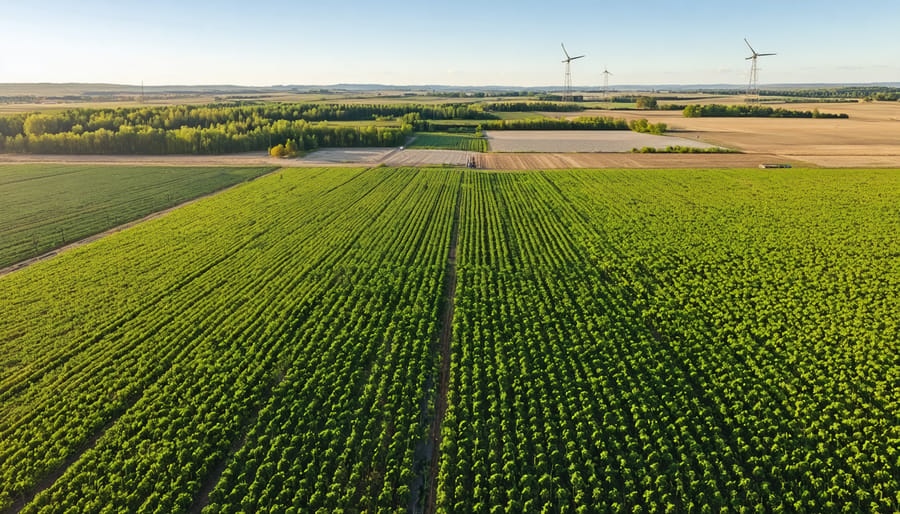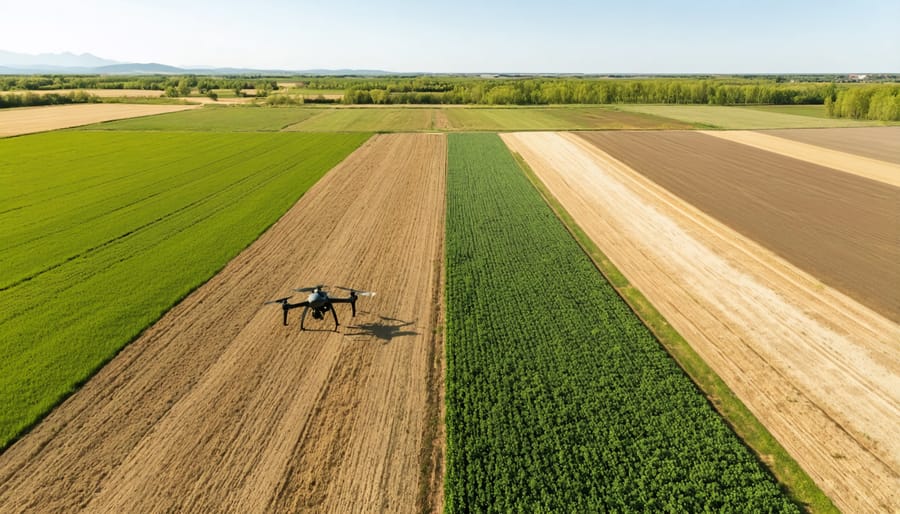Transform your fields into resilient ecosystems by implementing strategic natural pest control secrets that work specifically in Alberta’s challenging climate. Establish diverse crop rotations, incorporating brassicas and legumes, to disrupt pest life cycles and enhance soil health. Deploy beneficial insects like ladybugs and parasitic wasps through targeted habitat creation, installing flowering borders and shelter belts that thrive in Canadian growing zones 2-4. Monitor pest populations weekly using proven IPM techniques, including pheromone traps and systematic field scouting, to catch infestations before they reach economic threshold levels.
Practice companion planting with hardy varieties like marigolds, dill, and yarrow that naturally repel common Prairie pests while surviving temperature fluctuations from -40°C to +30°C. These integrated approaches have helped Alberta farmers reduce pesticide use by 40% while maintaining crop yields, demonstrating that effective pest management aligns with both environmental stewardship and agricultural productivity.
Smart Prevention: Your First Line of Defense
Companion Planting Success Stories
The Lethbridge Community Garden Project demonstrated remarkable success with their Three Sisters companion planting approach in 2022. By integrating corn, climbing beans, and squash, they reduced pest pressure by 60% compared to conventional single-crop plots. The corn provided natural support for beans, while squash’s broad leaves suppressed weeds and deterred pests.
In Red Deer County, the Thompson Family Farm reported an 80% reduction in aphid infestations after implementing companion planting strategies. Their innovative approach combined dill and calendula with their commercial cabbage operation, attracting beneficial insects that naturally controlled pest populations while maintaining crop quality.
The Medicine Hat Agricultural Research Station’s 2023 study showcased how intercropping carrots with onions significantly reduced carrot rust fly damage. Local farmer Sarah Chen adopted this technique, reporting a 70% decrease in pest-related crop losses and a 25% increase in marketable yield.
Perhaps most impressive is the success story from Clearwater County, where the Peterson Organic Farm integrated marigolds throughout their tomato fields. This simple addition led to a 90% reduction in nematode problems and improved soil health, as verified by provincial soil testing programs. Their companion planting model has since been adopted by twelve other organic farms across central Alberta.
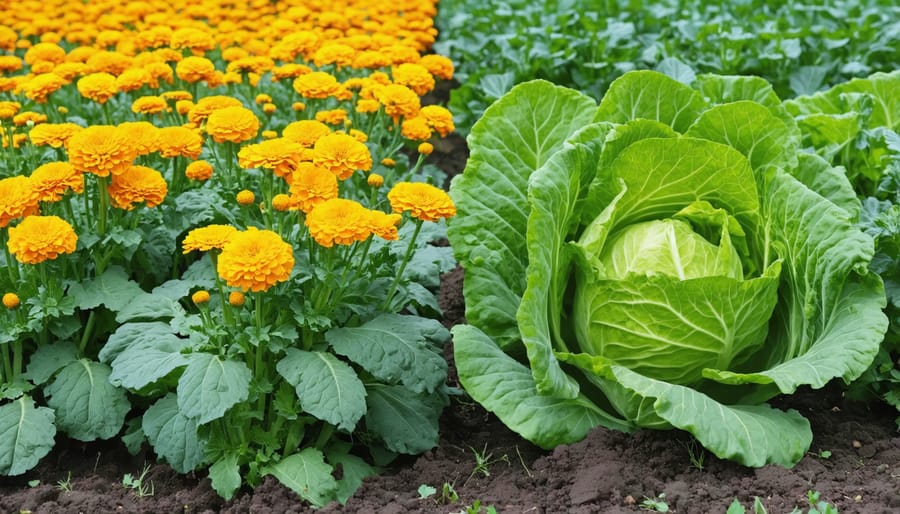
Building Healthy Soil Barriers
Building robust soil barriers against pests starts with understanding how to improve soil health through natural methods. Here in Alberta, we’ve seen remarkable success with crop rotation and cover cropping strategies that create an environment where beneficial organisms thrive while deterring harmful pests.
Start by incorporating organic matter through compost and green manure crops. This builds a strong soil structure that supports beneficial nematodes and microorganisms that naturally combat soil-borne pests. Many Alberta farmers have found success using fall rye and clover as cover crops, which not only enhance soil structure but also break pest cycles.
Adding beneficial minerals like calcium and maintaining proper pH levels (typically between 6.0-7.0) strengthens plant resistance to pest invasion. Consider implementing no-till or minimal tillage practices where possible, as this preserves soil structure and beneficial insect populations.
Mulching with locally sourced materials like straw or wood chips creates a physical barrier against pests while retaining moisture and promoting healthy root development. This practice has shown particular success in vegetable operations across central Alberta.
Remember to conduct regular soil tests to monitor nutrient levels and adjust your management practices accordingly. Many successful farmers in our region maintain detailed soil health records and report that balanced, healthy soil significantly reduces pest pressure while improving crop resilience.
Biological Control Methods That Work in Our Climate
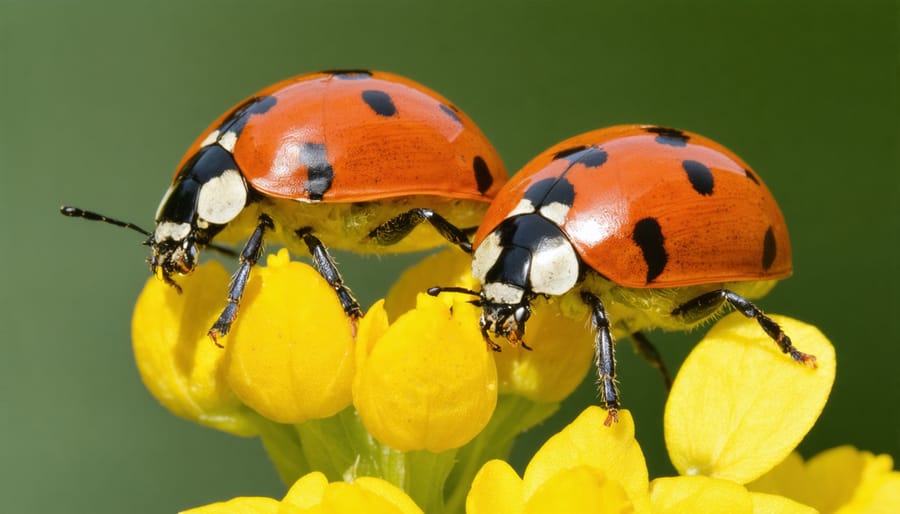
Beneficial Insects for Alberta Farms
Alberta farms benefit greatly from a diverse population of beneficial insects that provide natural pest control services. Understanding and attracting these helpful allies is crucial for implementing successful biological control methods in your fields.
Key beneficial insects include lady beetles, which effectively control aphids and scale insects, and parasitic wasps that target caterpillars and other crop-damaging larvae. Ground beetles are particularly valuable for controlling soil-dwelling pests, while hover flies help manage soft-bodied insects while also serving as important pollinators.
To attract and maintain these beneficial insects, consider establishing insectary strips with native flowering plants like yarrow, golden rod, and wild bergamot. These plants provide nectar and pollen throughout the growing season, ensuring your helpful insects have food sources when pest populations are low.
Creating overwintering habitats is essential in Alberta’s climate. Leave some areas with fallen leaves, wood mulch, or native grasses undisturbed to provide winter shelter. Hedgerows and windbreaks not only protect your crops but also offer year-round habitat for beneficial insects.
Monitor your fields regularly to identify both pest and beneficial insect populations. A simple sweep net can help you assess the balance between harmful and helpful insects. Remember that seeing some pest activity is normal and even necessary to maintain beneficial insect populations – aim for balance rather than complete pest elimination.
For best results, avoid broad-spectrum pesticides that can harm beneficial insects along with pests. Instead, focus on selective treatments when necessary, and give your natural allies time to establish effective control.
Microbial Solutions
Beneficial microorganisms have emerged as powerful allies in Canadian agriculture’s fight against crop pests. These microscopic warriors, including bacteria like Bacillus thuringiensis (Bt) and fungi such as Beauveria bassiana, work naturally to control pest populations while maintaining soil health.
In Alberta’s agricultural landscape, farmers have reported significant success using Bt-based solutions, particularly in controlling caterpillar pests in canola and vegetable crops. Local farmer James McKenzie from Lethbridge shares, “Since implementing microbial controls three years ago, we’ve reduced chemical pesticide use by 40% while maintaining crop yields.”
These beneficial microbes work through various mechanisms. Some produce compounds toxic to specific pests, while others parasitize harmful insects directly. The beauty of microbial solutions lies in their specificity – they target pest species while leaving beneficial insects unharmed.
Application methods vary by crop type and target pest. For best results in our prairie climate, apply microbial solutions during early morning or evening when humidity levels are higher. Most products can be applied using standard spray equipment, making integration into existing farm operations straightforward.
Alberta Agriculture recommends starting with small trial areas to understand how these solutions work in your specific conditions. Many successful implementations begin with greenhouse crops before expanding to field applications. Remember that microbial solutions work best as part of an integrated pest management strategy, complementing other control methods like crop rotation and physical barriers.
Storage and handling requirements are crucial – most products need cool, dry conditions to maintain efficacy. Local agricultural supply stores now stock an increasing range of microbial products specifically tested for Canadian growing conditions.
Physical and Mechanical Controls
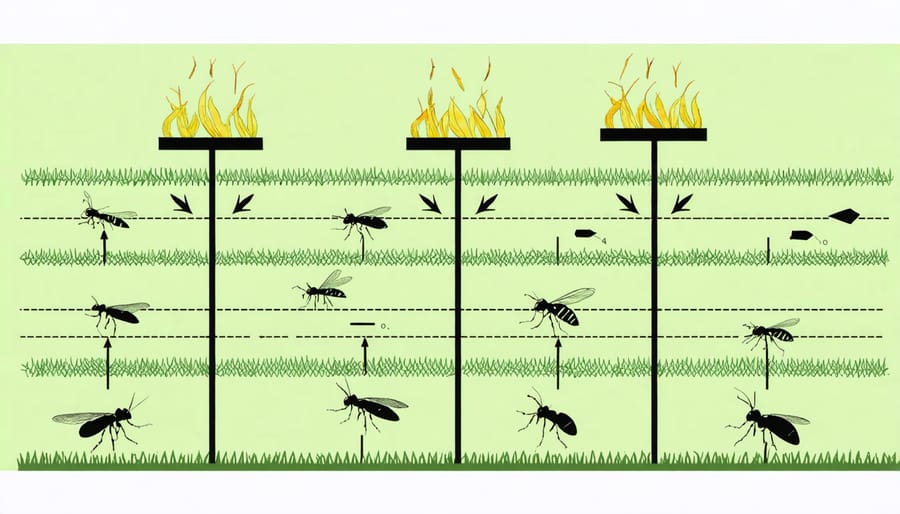
Trapping Systems
Trapping systems play a vital role in Alberta’s integrated pest management strategy, offering farmers effective and environmentally conscious solutions for pest control. For rodent management, snap traps and live-capture devices remain reliable options, particularly when positioned along walls and known travel routes. Multi-catch traps work exceptionally well for mice in grain storage facilities, while larger single-catch traps are ideal for controlling pocket gophers in field margins.
For flying insects, pheromone traps have proven highly successful in monitoring and managing moth populations, particularly in canola and wheat crops. These traps should be placed strategically at heights of 1-1.5 metres and checked weekly during peak seasons. Light traps, especially those using LED technology, effectively capture nocturnal pests while consuming minimal energy.
Sticky traps serve dual purposes – monitoring pest populations and reducing their numbers. Yellow sticky cards work particularly well for aphids and whiteflies, while blue ones attract thrips. For optimal coverage, place one trap per 100 square metres of crop area.
Local success stories have shown that combining different trapping methods yields the best results. For instance, several Peace Region farmers reported up to 70% reduction in pest damage by implementing a comprehensive trapping system that includes both ground and aerial traps. Remember to check and maintain traps regularly, replacing them when necessary to ensure continued effectiveness.
Barrier Methods
Physical barriers are among the most effective and environmentally friendly approaches to pest management on Alberta farms. Installing proper fencing, netting, and row covers creates reliable protection against various pests while maintaining crop health. For example, many Peace Country farmers have successfully used floating row covers to protect their brassica crops from flea beetles and cabbage moths.
Fine-mesh screens and netting, when properly installed, can effectively block flying insects while still allowing adequate airflow and sunlight. For greenhouse operations, installing insect screens on vents and openings has proven particularly successful in preventing whitefly and aphid infestations.
Mechanical barriers like copper strips have shown excellent results in deterring slugs and snails, while collar barriers around young plants protect against cutworms – a common challenge in central Alberta. Strategic mulching with materials like straw or wood chips creates an additional barrier that many crawling insects find difficult to navigate.
For larger operations, electric fencing has become increasingly popular for deterring larger pests like deer and elk. Many farmers in the foothills region have reported significant reductions in crop damage after installing solar-powered electric fencing systems.
Remember to regularly inspect and maintain your barrier systems, especially after severe weather events. Damaged barriers can create entry points for pests, potentially compromising your entire protection strategy. Consider combining barrier methods with other pest management techniques for optimal results.
Emergency Organic Solutions
Approved Organic Sprays
Several organic pesticide solutions are approved for use in Canadian agriculture, each offering specific benefits for different pest challenges. Neem oil, derived from neem tree seeds, effectively controls a wide range of insects while being safe for beneficial organisms. For fungal issues, copper-based sprays are particularly useful in Alberta’s humid conditions, though they should be applied sparingly to maintain soil health.
Bacillus thuringiensis (Bt) sprays work exceptionally well against caterpillars and other leaf-eating insects, making them ideal for canola and vegetable crops. Spinosad, derived from soil bacteria, offers excellent control of thrips and leafminers while having minimal impact on beneficial insects.
When applying these sprays, timing is crucial. Early morning or evening applications typically yield better results, and it’s essential to maintain proper coverage while following label instructions for dilution rates. Remember to rotate between different organic sprays to prevent pest resistance and maintain their effectiveness throughout the growing season. Always check with your local organic certification body to ensure compliance with current regulations.
When to Act
Timing is crucial in pest management, and successful intervention depends on regular monitoring and understanding pest life cycles. In Alberta’s agricultural regions, most pest problems follow seasonal patterns, with key intervention windows occurring during spring emergence and mid-summer population peaks.
Begin monitoring your fields as soon as soil temperatures reach 5°C in spring. Scout your fields at least twice weekly during critical growth stages, paying special attention to crop edges and areas near shelterbelts. Use established economic thresholds as your decision-making guide – these are scientifically determined levels at which pest control becomes economically justified.
For most crops in Alberta, early detection and swift action during the seedling stage are vital. However, avoid premature intervention, as natural predator populations often help regulate pest numbers. Consider weather forecasts in your decision-making; upcoming rainfall might naturally control soft-bodied insects, while hot, dry conditions could accelerate pest reproduction.
Document your observations and intervention timing each season. This creates valuable historical data that helps predict future pest pressures and optimal treatment windows specific to your farm.
As we’ve explored throughout this guide, successful pest management in Alberta’s agricultural landscape requires a thoughtful, multi-faceted approach. By combining preventive measures like crop rotation and beneficial insect habitat creation with targeted biological controls, farmers across our province are achieving remarkable results while reducing their environmental impact.
The key to sustainable pest management lies in viewing our farms as interconnected ecosystems rather than isolated production units. As demonstrated by numerous Alberta farmers, integrating multiple control strategies not only provides better pest control but also promotes soil health and biodiversity. Remember that successful pest management is a community effort – sharing experiences and knowledge with neighbouring farms can strengthen our collective response to pest challenges.
Looking ahead, the adoption of sustainable pest management practices isn’t just an environmental choice – it’s an economic imperative. With increasing consumer demand for sustainably produced food and growing regulatory pressure on chemical pesticides, now is the time to embrace these methods.
Take small steps to start – perhaps by introducing companion planting or establishing monitoring protocols – and gradually expand your sustainable pest management program. Connect with local agricultural extension services and fellow farmers who have successfully implemented these techniques. Remember, every farm’s journey toward sustainable pest management is unique, but the goal remains the same: creating resilient, productive agricultural systems that will serve our communities for generations to come.




